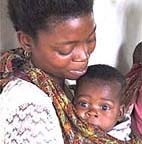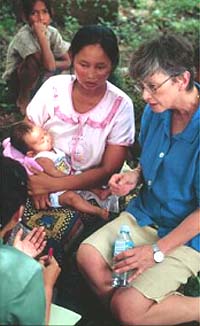|
||||

|
|
|
|
GAVI The Global Alliance for Vaccines and Immunization As the Alliance enters its third year, Carol Bellamy, chair of the GAVI Board and Executive Director of UNICEF, explains how the immunization initiative is moving forward
Why? “Because it is hard to find a better story, a better real story,” she says. Immunization works. “It is highly cost-effective and there is an increasing understanding that it plays a very important role in reducing child and infant mortality…. This is a positive development story that can really shoot a hole in development fatigue.” As Executive Director of the United Nations Children’s Fund, UNICEF, Ms Bellamy is also currently the chair of the Board of the Global Alliance for Vaccines and Immunization. Two years after GAVI’s launch, she is pushing ahead towards its goals, as well ensuring that the Alliance builds on what it has learnt so far. By the end of the five-year commitments made by GAVI, she hopes, the health ministries in the poorest countries will have built stronger infrastructures for immunization than ever before. A broader array of vaccines will be part of routine immunization everywhere. And a new mechanism of international aid pioneered by the Alliance – awards that are made according to results – will be seen as a success. How far has the Alliance progressed towards these goals so far? It is still early days, says Ms Bellamy, because the first deliveries of vaccines to countries have only recently begun. But no one doubts that the pace so far has been fast: 53 of the 74 eligible countries – those with an income per head of less than US$1000 – have already been approved for support from GAVI and the Vaccine Fund. Just as important, she says, the world has been sent a strong message. The initial gift of US$750 million from the Bill and Melinda Gates Foundation to the Vaccine Fund was “a much needed financial infusion at a time of increasing ‘aid drowsiness’”, says Ms Bellamy. The new private-public partnership drew attention at the highest political level to a very efficient health intervention and it has attracted substantial further donations from seven industrialized countries. So far, over US$1 billion has been committed to the Fund. But Ms Bellamy is under no illusions about the tasks ahead. A key challenge is to harness more money. The Vaccine Fund puts the total cost of achieving the Alliance’s five-year goals at around $2 billion, so another $1billion is needed. But the climate is tougher than at the end of the 1990s. “We are now dealing with a much tighter global economy,” says Ms Bellamy. She believes the Alliance partners need to work hard with countries to explore different mechanisms, including allocating debt relief in the poorest countries towards immunization. “Hopefully countries will see this as a good opportunity for investing some of these funds,” says Ms Bellamy. With evidence of such commitment from the countries themselves, even at modest levels, she hopes that traditional donors may be willing to come up with new support. But funding is not everything: a critical requirement for success is the commitment of each government to improving its own immunization system. “There really has to be a buy-in at country level,” says Ms Bellamy. In her visits to Mozambique and Cambodia, where the first GAVI vaccines were delivered last year, she saw this commitment at first hand. This is also where the new approach to funding pioneered by GAVI comes in. Hoping to increase political buy-in, the Alliance and the Vaccine Fund award countries money to strengthen their immunization systems on the basis of performance. From each country’s point of view, there is greater freedom than in most international aid programmes: the government can decide exactly how it will use the money to improve its performance. In return, the Alliance focuses on results: if a country increases its coverage (the percentage of children fully immunized), it gets more money. If it does not – and the figures are independently audited – the funding stops. The brand-new mechanism is being evaluated now, as a high priority, says Ms Bellamy. Outside GAVI, too, the idea has attracted interest from other international development initiatives. “I think this approach has the potential to be emulated elsewhere,” says Ms Bellamy, although she cautions that definitions of the “results” of any health-related investment need to be carefully thought out. What has the Alliance learnt so far that could change its approach? First, says Ms Bellamy, there has been an important recognition that the Alliance needs to support countries in strengthening their routine immunization services, as well as helping them to increase the number of vaccines they provide. Initially, GAVI was criticised for allocating less than one-fifth of its spending from the Fund to strengthening immunization services, while spending most of the money on under-used vaccines. Today, five-year commitments for strengthening routine services have increased markedly, to some $269 million, just over one-third of the total; in addition, more than $11 million has been allocated over three years to help countries increase injection safety. “Strengthening routine immunization has a multiplier effect and helps the strengthening of the health system as a whole,” says Ms Bellamy. There are several other key questions that the Alliance must ask itself as it moves into its third year. First, how to ensure a steady supply of vaccines in a market with few players. In the first two years of the Alliance’s work, demand from the countries for certain combination vaccines has far exceeded the available supply and countries have been asked to accept alternative presentations of the vaccines. UNICEF, which procures vaccines on behalf of most of the governments and the Vaccine Fund, must work with the industry to find ways of making the supply more predictable, says Ms Bellamy. She also wants to streamline the procurement system itself. The role of the vaccine industry within the Alliance itself has attracted some critics who say individual companies should not have seats on the Board because of the potential conflict of interest. Ms Bellamy responds that the goal of the partnership – increasing children’s access to immunization – is probably brought closer overall by having the industry directly involved. At all times, Ms Bellamy makes clear that the ultimate goal is better immunization, beyond the lifetime of the Alliance itself. “Immunization existed before GAVI and it will continue after GAVI,” she says. While the Alliance partners will need to keep convincing potential investors of the value of immunization, she says, governments’ own commitment will determine whether sustainable funds can always be mobilized. Equally important, she says, it is vital that all players face up to the fact that there are “real costs” in bringing a broader range of vaccines to a greater number of the world’s children. Immunization cannot be done well on the cheap. But its costs are still relatively small, she says, compared with the enormous benefits that the increased investment will bring. Arguing that case effectively is a key task for GAVI. “Let’s make sure we make a difference.”
|
|
| Contact GAVI | Guestbook | Text version | Credits and Copyright | |

 CAROL
Bellamy is a realist.
CAROL
Bellamy is a realist.